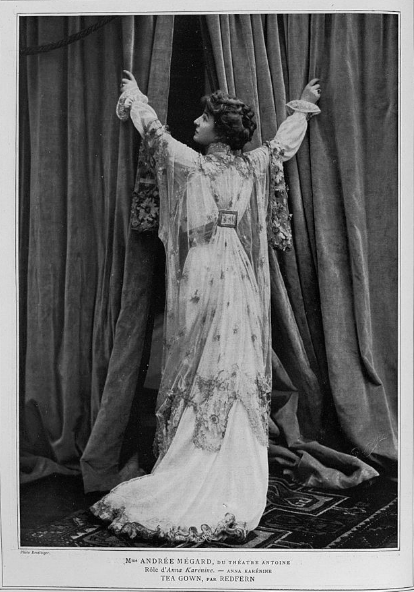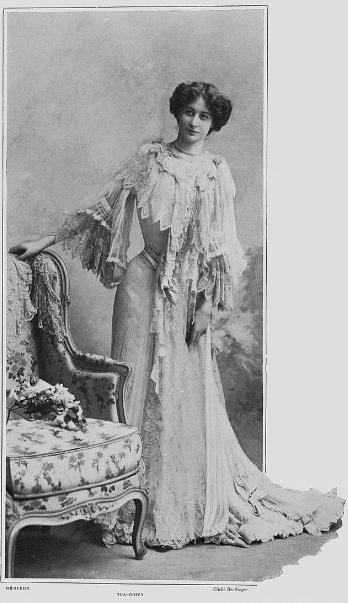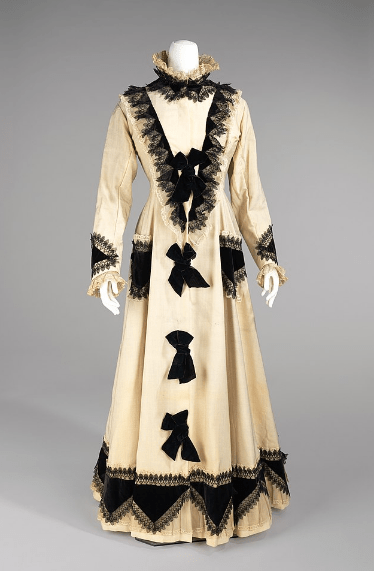In general, women’s fashion during the 1800s had the tendency to be restrictive and uncomfortable, but it was all for the sake of physical beauty.
Corsets, crinolines, crinolettes, and bustles were among those fashion trends designed to give a women’s body a flattering silhouette. But wearing any of them was not only an uncomfortable, inconvenient, and painful experience, but it proved to be detrimental to women’s health, especially when worn for a prolonged period.
But fortunately, after a difficult day at the mercy of the crinoline, crinolette, bustle, and the corset, 19th-century women could now find comfort and relief in the tea gown.
The tea gown, a unique and elegant garment from the late 19th and early 20th centuries, played a significant role in women’s fashion history. It emerged during the Victorian era, a period known for its strict social codes and formal dress requirements. The tea gown was a response to these rigid norms, offering women a more relaxed, comfortable option for informal at-home entertaining.
A tea gown was a woman’s dress that was typically worn at home when informally entertaining guests. The tea gown was either loose and straight or semi-fitted, usually with long sleeves, a high collar, and long (and usually loose and flowing) sleeves. It was a cross between a robe and a ball gown.
Origin and Evolution
Tea gowns took their inspiration from somewhere in the Far East. The earliest-known tea gowns were evident of Asian influence, as their loose-sleeved features resembled those of the Japanese kimono. Aside from that, a historical approach from the 1700s – particularly the Rococo period – also led to the renaissance period dresses that featured long, flowing sleeves.
- Late 19th Century: The tea gown originated in the 1870s. It was initially worn by upper-class women for private, at-home occasions, especially during the late afternoon tea time, which was a popular social event.
- Hybrid Design: The gown combined the formal elements of outdoor dress with the comfort of indoor wear. It often featured flowing lines, loose fits, and lacked the rigid corseting that characterized most women’s fashion of the time.
- Artistic and Aesthetic Influences: The tea gown was influenced by the Aesthetic Movement and later the Arts and Crafts Movement. Designers like Liberty & Co. in London promoted artistic dress that was both beautiful and comfortable.
Characteristics
While the tea gown was usually considered as a house dress because of its relative informality and comfort, it was nevertheless consummately elegant. Depending on the wearer’s preference, she might wear a loose-fitting corset or no corset at all, although tea gowns were really intended to be worn without a corset.
- Materials and Embellishments: Made from luxurious fabrics like silk, velvet, and lace, these gowns were often adorned with intricate embroideries, ruffles, and floral motifs.
- Silhouette and Style: The silhouette evolved over the years. Initially, tea gowns had a more fitted bodice with a fuller skirt. Later designs leaned towards a straighter, more flowing line, influenced by Art Nouveau styles.
- Combination of Formality and Comfort: While more comfortable than formal outdoor attire, tea gowns still maintained a level of sophistication and elegance suitable for receiving guests.
Cultural and Social Significance
However, wearing tea gowns was limited within the confines of one’s home. It was considered inappropriate for women to be wearing tea gowns outside of their homes and in public. They were intended to be worn only indoors with family members and close friends during a gathering.
- A Sign of Status: Owning a tea gown was a sign of social status and wealth, as it indicated the leisure and means to host social events at home.
- A Step Towards Casual Dress: The tea gown was a precursor to more relaxed fashion norms in women’s clothing. It was a rebellious statement against the constraints of corseted fashion.
- Feminine Ideal and Artistic Expression: It represented an ideal of feminine beauty and grace, influenced by romantic and artistic ideals of the time.
Decline and Legacy
- Early 20th Century: The popularity of tea gowns declined after World War I as fashion trends shifted towards simpler, more practical clothing.
- Influence on Modern Fashion: Elements of the tea gown can still be seen in today’s fashion, particularly in evening wear and bridal gowns that emphasize comfort, fluidity, and elegance.
Compared to the corset and other types of restrictive clothing items, the tea gown could be easily put on by the wearer herself without needing the maids’ assistance. It was sewn with soft, sumptuous fabrics and decorated with lots of lace. Some tea gowns also featured long trains.
By the mid-1880s, tea gowns were considered in vogue, particularly among followers of the aesthetic movement, who believed that life was meant to be lived intensely, along with an ideal of beauty.
As drinking tea was an afternoon pastime especially among the aristocrats, tea gowns were intended to be worn during midday. As mentioned before, tea gowns featured high collars. But some tea gowns also featured a low collar or a small opening at the neck, and this variation was usually worn during the evening. Women began wearing tea gowns in the evening for informal dinners at home with family and friends at the turn of the century.
By the 1920s, the popularity of tea gowns had begun to wind down, by which time they were quite sheer and lightweight. They were typically made of sheer, light fabric or metallic thread, giving them a somewhat shimmering look. During the Victorian era, women are also expected to wear a mourning dress, which is also a sign of etiquette. Learn more about it in our post, What Can Victorian Mourning Dress Teach Us About the Fashion of Grief?



